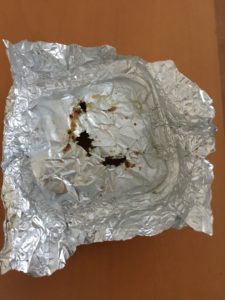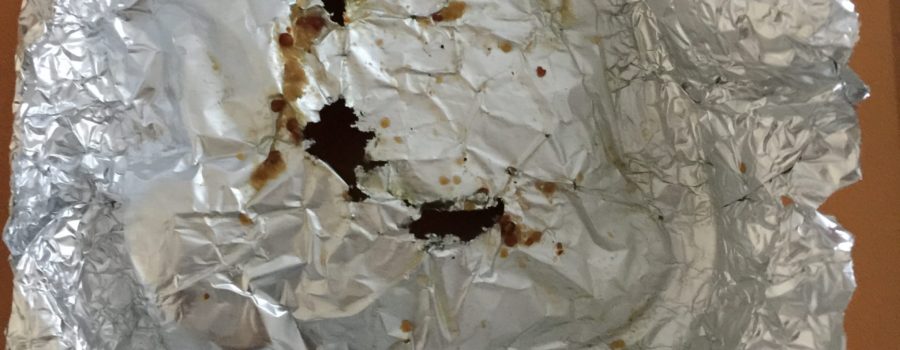Aluminum Foil Experiment


“Aluminum foil experiment” it’s probably an intriguing title for this post, but couldn’t think of a better name.
Over 20 years ago I noticed that the aluminum foil I used to cover a bowl with chicken salad was…. corroded in the middle, where it sagged and touched the salad. My recipe makes the salad a bit more acidic because I use pickles and mustard, not just mayo. This may probably be the reason why the aluminum reacted with the salad, I guess.
Of course, I stopped using the foil to cover anything but I recently thought to re-do this aluminum foil experiment, and the same thing happened again. Not that I’m surprised, it’s just that back then we didn’t have smart phones or Facebook and couldn’t take a picture like this to post.
If I hadn’t seen the holes and the silvery spots after removing the cover, we’d have eaten it. I also noticed the discoloration of the aluminum foil used to wrap or cover something with (fish, for instance) cooked on the grill or in the oven. You probably noticed this as well.
That’s why some of that aluminum we use when cooking and storing our dishes, gets into some foods and we end up eating it. Aluminum it’s not one of the elements that is naturally part of our body, thus we are not equipped to process (metabolize) it. Don’t assume it just passes through the digestive system and entirely comes out at the other end.
It doesn’t work like this in biology, our body does some work to “accommodate” it and but cannot. As a result, it can accumulate in the liver, kidney, brain, and bones.
It baffles me anytime I see products and their label says something like “natural aluminum.” Usually when reading “natural” on a products I purchase, I assume that’s something good for us, something naturally present in our metabolism. Aluminium is not! If anything, it’s a toxic metal.
Aluminium in foods and drinks has increased over the last two decades due to its increased content in soils, subsequent to the industrial production. It is also added to drinking (and irrigation) water, used as food additive, and included in some medications.
I would think additional exposure from food packaging and cooking utensils it’s not something desirable, let alone “natural.” As you noticed how aluminum reacted with my food, it’s unlikely to be an “inert” component at all. It’s not just there for the ride, it is more than that
You’re probably wondering right about now what can be used in place. As usual, at the end of my articles I reveal what I use as replacement for any products I don’t think are safe anymore.
In this day and age there is “a silver lining” for anyone used to cooking with aluminum foil. That is parchment paper, not the teflon coated one though. One of brands that I use also makes parchment paper bags, paper loaf and cakes pans—work well in the oven. You can check out these products on my Facebook page—titled Keep Away from GRAS.
Of course, can’t put a fish on the grill wrapped in parchment paper. I place it in a (stainless steel) pan and cook it with indirect heat (this means the burners underneath the pan are off and just the side ones are working). After all, when placing the fish in aluminum foil it comes out more like baked, not grilled.
If grilling it’s a must, there are inexpensive stainless steel baskets specifically used for fish and vegetables, some have a folding mechanism and a wood handle that makes flipping it over very easy.



